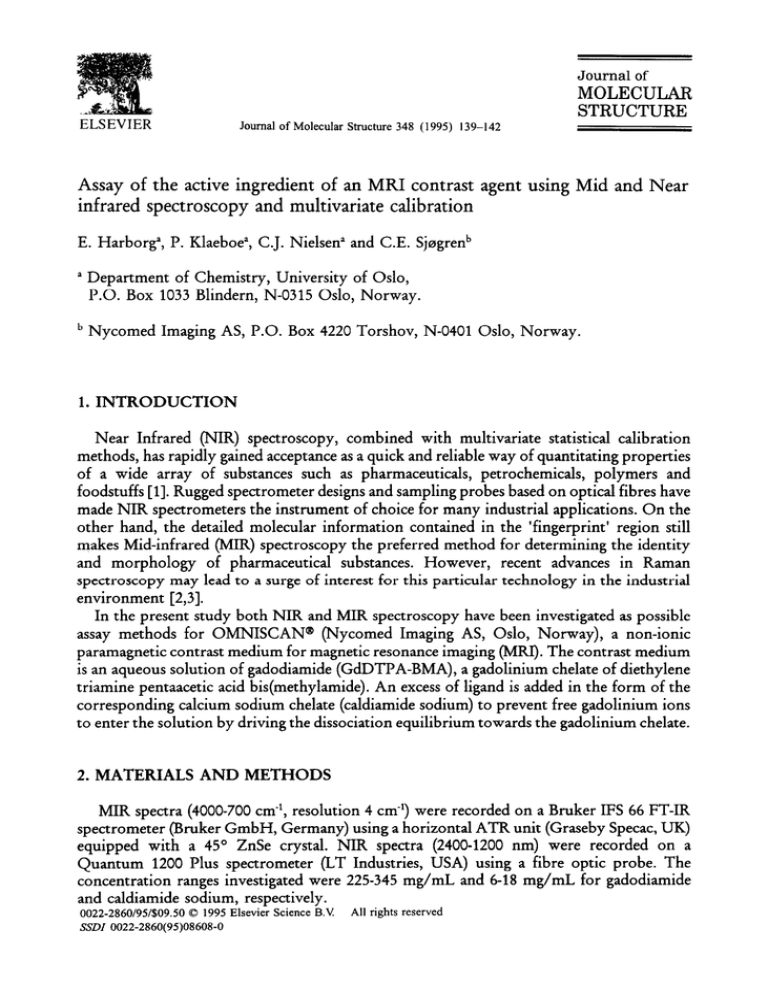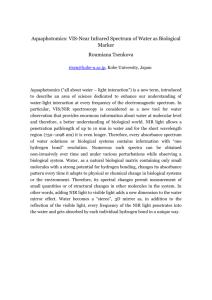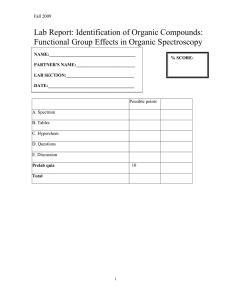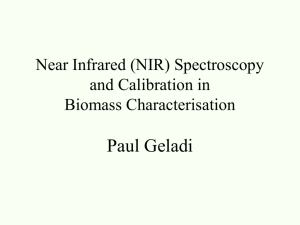MOLECULAR STRUCTURE Assay of the active ingredient ...
advertisement

Journal of MOLECULAR STRUCTURE ELSEVIER Journal of Molecular Structure 348 (1995) 139-142 Assay of the active ingredient of an MRI contrast agent using Mid and Near infrared spectroscopy and multivariate calibration E. Harbo@, I?. Klaeboea, C.J. Nielsen” and C.E. Sjogrenb a Department of Chemistry, University of Oslo, P.O. Box 1033 Blindern, N-0315 Oslo, Norway. b Nycomed Imaging AS, P.O. Box 4220 Torshov, N-0401 Oslo, Norway. 1. INTRODUCTION Near Infrared (NIR) spectroscopy, combined with multivariate statistical calibration methods, has rapidly gained acceptance as a quick and reliable way of quantitating properties of a wide array of substances such as pharmaceuticals, petrochemicals, polymers and foodstuffs [ 11. Rugged spectrometer designs and sampling probes based on optical fibres have made NIR spectrometers the instrument of choice for many industrial applications. On the other hand, the detailed molecular information contained in the ‘fingerprint’ region still makes Mid-infrared (MIR) spectroscopy the preferred method for determining the identity and morphology of pharmaceutical substances. However, recent advances in Raman spectroscopy may lead to a surge of interest for this particular technology in the industrial environment [2,3]. In the present study both NIR and MIR spectroscopy have been investigated as possible assay methods for OMNISCAN@ (Ny corned Imaging AS, Oslo, Norway), a non-ionic paramagnetic contrast medium for magnetic resonance imaging (MRI). The contrast medium is an aqueous solution of gadodiamide (GdDTPA-BMA), a gad o 1inium chelate of diethylene triamine pentaacetic acid bis(methylamide). An excess of ligand is added in the form of the corresponding calcium sodium chelate (caldiamide sodium) to prevent free gadolinium ions to enter the solution by driving the dissociation equilibrium towards the gadolinium chelate. 2. MATERIALS AND METHODS MIR spectra (4000-700 cm-‘, resolution 4 cm-l) were recorded on a Bruker IFS 66 FT-IR spectrometer (Bruker GmbH, Germany) using a horizontal ATR unit (Graseby Specac, UK) equipped with a 45’ ZnSe crystal. NIR spectra (2400-1200 nm) were recorded on a Quantum 1200 Plus spectrometer (LT Industries, USA) using a fibre optic probe. The concentration ranges investigated were 225345 mg/mL and 6-18 mg/mL for gadodiamide and caldiamide sodium, respectively. 0022-2860/95/$09.50 0 1995 Elsevier Science B.V SSDI 0022-2860(95)08608-O All rights reserved 140 Data treatment and calibration was carried out using the ‘Unscrambler’ software (CAM0 AS, Norway). Several methods for pretreatment of the data (normalization and differentiation), as well as various multivariate calibration approaches, Principal component regression (PCR) and Partial least squares regression (PLSl and PLS2), were tested in order to arrive at the best possible calibration model. The calibration models were validated with test sets consisting of spectra not contained in the calibration set. The long term precision (reproducibility) of the MIR calibration models was furthermore investigated by predicting the concentrations of a number of samples analyzed over an extended period of time. The Root mean square error of prediction (RMSEP) obtained on this set of samples was used as a measure of how well the calibration models performed. 3. RESULTS AND DISCUSSION Since the two target compounds, gadodiamide and caldiamide sodium, differ only in the metal ion chelated with the DTPA-BMA ligand, it is obvious that only minor differences are expected when spectra of the two substances are compared. Fig. 1 shows that this is indeed the case. The only visible difference observed in the MIR spectra of pure aqueous solutions of the two compounds is a shift of the band at oz. 1110 cm-‘. In the NIR spectra no such differences could be detected. This observation led us to believe that the information content of the MIR spectra would allow us to predict the amounts of both components in a mixture. More subtle spectral differences may of course be present, both in the MIR and in the NIR regions, but this information may only be extracted and utilized for calibration purposes by a multivariate approach. Absorbance 0.60 I4 1496 1303 1110 Wavenumberskm-1 Figure 1. Mid-infrared (MIR) spectra of aqueous gadodiamide and caldiamide sodium. 3.1. NIR spectroscopy The optimum calibration results with the NIR data set were obtained with a PLSl model using four factors. No pretreatment was applied to the spectra. Fig. 2 shows a plot of the predicted gadodiamide content versus known concentrations in the test set samples used to validate the calibration model. Gadodiamide, which is the major constituent of the samples, was successfully predicted with an RMSEP value of 4 mg/mL, i.e. 1.4% of the median of the concentration range. 141 This estimate compares favourably with the reproducibility of the chromatographic test method currently used as an assay of OMNISCAN@. However, the amount of caldiamide sodium could not be predicted with sufficient precision by NIR spectroscopy. This is interpreted as a failure of the broad overtone bands in the NIR region to reflect the subtle differences between the two analytes. In a mixture of two components, ideally two or three factors are expected to be sufficient to model the structure in the data set. In the present case four factors were found to give the optimum results, but a reasonable prediction was also obtained with two and three factors (RMSEP values of ca. 6 mg/mL). However, since the NIR approach turned out not to give a satisfactory quantitative calibration for caldiamide sodium, the attention was focused on the MIR rather than a further optimization of the NIR procedure. Predicted mg/mL (with 4 factors) Predicted mg/mL (with 3 factors) 350 350 325 325 300 300 275 275 250 250 225 225 -i 225 250 275 300 325 350 Gadodiamide (known content) mg/mL Figure 2. Gadodiamide content and PLSl prediction with NIR data. RMSEP 3.25 225 250 275 300 325 350 Gadodiamide (known content) mg/mL Figure 3. Gadodiamide content and PLSl prediction with MIR data. 3.2. Mid infrared spectroscopy Figs. 3 and 4 show the quantitative results obtained with multivariate calibrations based on MIR spectra. The plots show the predicted versus known concentrations in a set of samples analyzed over an extended period of time. Optimum calibration results were obtained by restricting the spectral region to the 1500-900 cm-’ ‘fingerprint’ range, followed by normalisation and differentiation (first derivative) of the spectra. The results shown here were obtained using PLSl calibration, but similar results were also obtained with PCR models. In a discussion of the relative merits of the two calibration procedures [4] it is claimed that the two approaches normally give similar results. However, a PLSl model may in some cases have a better chance of leading to an acceptable model than the PCR approach, particularly if the spectra (X-variables) contain a large variation irrelevant to the modelling of the Y-variables (concentrations). 142 Using a PLSl model with three factors the gadodiamide content was predicted with an RMSEP value of 3.3 mg/mL (Fig. 3), w h ich is somewhat better than the NIR results. An important difference in the way the models were tested supports our conclusion: The MIR prediction was carried out on a set of spectra Predicted mg/mL (with 4 factors) recorded over a period of several months, and ,,I the RMSEP value thus obtained is an estimate ” . RMSEP 1.29 of the expected long term precision (rtproducibility) of the MIR method. The “. 14 spectra used to validate the NIR model, on the other hand, were recorded on the same day. 12 Hence, the RMSEP value obtained with the 10 . NIR data (4.0 mg/mL) is a measure of the short term precision (repeatability) of the ’_ method, which with proper statistical control 6 .I 6 6 10 12 14 16 16 of the analytical procedure, is better than or Caldiamide Sodium (known content) mg/mL equal to the long term precision. As opposed to the NIR models the amount of the excipient, caldiamide sodium, could be Figure 4. Caldiamide sodium content predicted with some degree of success by and PLSl prediction with MIR data. models based on the MIR spectra. However, the RMSEP value of 1.3 mg/mL obtained with a four-factor PLSl model of the caldiamide sodium content (Fig. 4) corresponds to ca. 10% of the median concentration value. This, clearly, does not represent a sufficiently high precision for the MIR method to replace the titration method currently used to determine the amount of caldiamide sodium in OMNISCAN@. The failure of the MIR calibration to yield the desired result, despite the underlying spectral differences which were commented upon initially (Fig. l), must be attributed to the large difference in concentration (a factor of 20) between the two components in the mixtures studied here. 4. CONCLUSION NIR and MIR spectroscopy combined with multivariate calibration were assessed as potential quantitative methods for the determination of two, structurally very similar, metal chelates in an aqueous mixture. Both methods gave a satisfactory prediction of the main component, whereas the minor component could only be detected with MIR spectroscopy. REFERENCES 1. 2. 3. 4. D. A. Burns and E. W. Ciurczac (eds.), Handbook of Near-Infrared Analysis, Marcel Dekker, New York, 1992. B. Chase, Applied Spectroscopy 47 (1994) 14A. F.J. Bergin and H.F. Shurvell, Applied Spectroscopy 43 (1989) 516. H. R. Bjrarsvik and H. Martens, in Handbook of Near-Infrared Analysis, D. A. Burns and E. W. Ciurczac (eds.), Marcel Dekker, New York, 1992.





